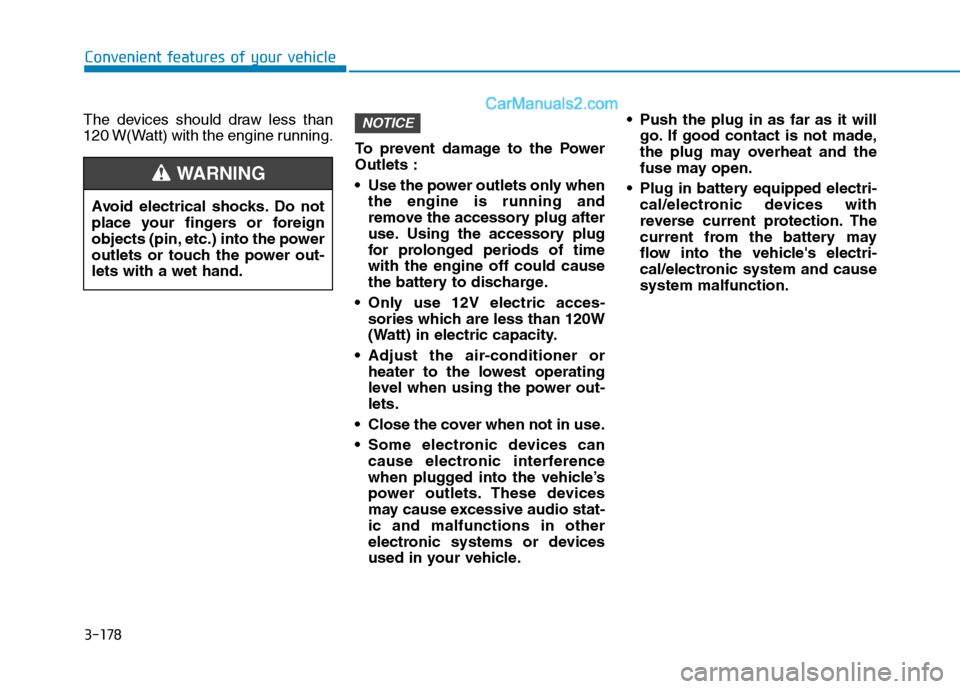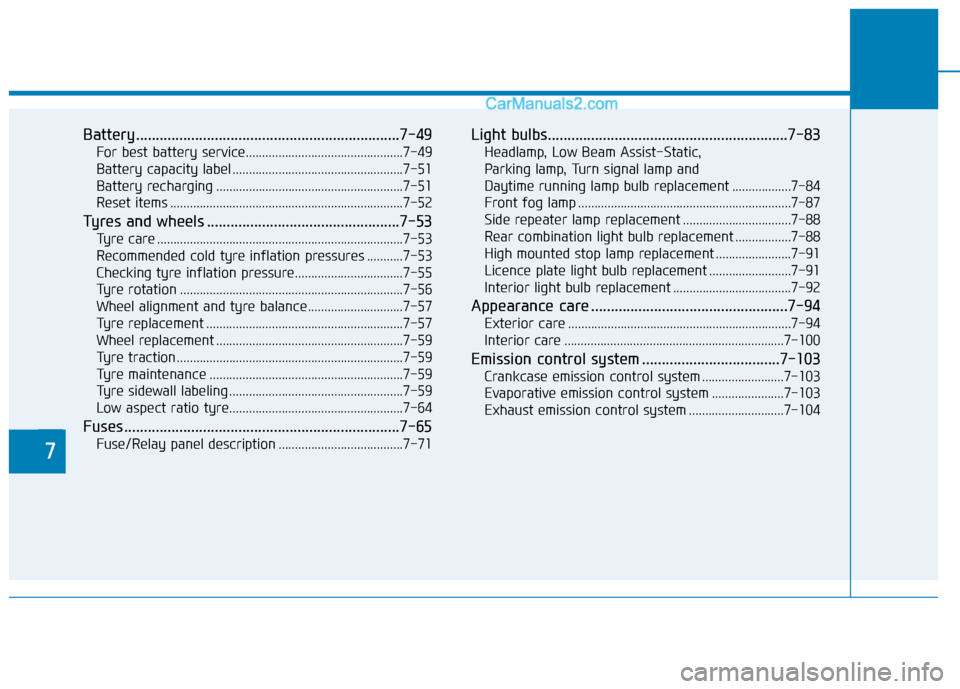Page 264 of 637

3-178
Convenient features of your vehicle
The devices should draw less than
120 W(Watt) with the engine running.
To prevent damage to the Power
Outlets :
Use the power outlets only when
the engine is running and
remove the accessory plug after
use. Using the accessory plug
for prolonged periods of time
with the engine off could cause
the battery to discharge.
Only use 12V electric acces-
sories which are less than 120W
(Watt) in electric capacity.
Adjust the air-conditioner or
heater to the lowest operating
level when using the power out-
lets.
Close the cover when not in use.
Some electronic devices can
cause electronic interference
when plugged into the vehicle’s
power outlets. These devices
may cause excessive audio stat-
ic and malfunctions in other
electronic systems or devices
used in your vehicle. Push the plug in as far as it will
go. If good contact is not made,
the plug may overheat and the
fuse may open.
Plug in battery equipped electri-
cal/electronic devices with
reverse current protection. The
current from the battery may
flow into the vehicle's electri-
cal/electronic system and cause
system malfunction.
NOTICE
Avoid electrical shocks. Do not
place your fingers or foreign
objects (pin, etc.) into the power
outlets or touch the power out-
lets with a wet hand.
WARNING
Page 518 of 637

7
Battery...................................................................7-49
For best battery service................................................7-49
Battery capacity label ....................................................7-51
Battery recharging .........................................................7-51
Reset items .......................................................................7-52
Tyres and wheels .................................................7-53
Tyre care ...........................................................................7-53
Recommended cold tyre inflation pressures ...........7-53
Checking tyre inflation pressure.................................7-55
Tyre rotation ....................................................................7-56
Wheel alignment and tyre balance.............................7-57
Tyre replacement ............................................................7-57
Wheel replacement .........................................................7-59
Tyre traction .....................................................................7-59
Tyre maintenance ...........................................................7-59
Tyre sidewall labeling .....................................................7-59
Low aspect ratio tyre.....................................................7-64
Fuses ......................................................................7-65
Fuse/Relay panel description ......................................7-71
Light bulbs.............................................................7-83
Headlamp, Low Beam Assist-Static,
Parking lamp, Turn signal lamp and
Daytime running lamp bulb replacement ..................7-84
Front fog lamp .................................................................7-87
Side repeater lamp replacement .................................7-88
Rear combination light bulb replacement .................7-88
High mounted stop lamp replacement .......................7-91
Licence plate light bulb replacement .........................7-91
Interior light bulb replacement ....................................7-92
Appearance care ..................................................7-94
Exterior care ....................................................................7-94
Interior care ...................................................................7-100
Emission control system ...................................7-103
Crankcase emission control system .........................7-103
Evaporative emission control system ......................7-103
Exhaust emission control system .............................7-104
Page 567 of 637

7-51
7
Maintenance
Battery capacity label
❈The actual battery label in the vehicle
may differ from the illustration.
1. CMF60L-BCI : The HYUNDAI
model name of battery
2. 12V : The nominal voltage
3. 60Ah(20HR) : The nominal capacity
(in Ampere hours)
4. 92RC : The nominal reserve capac-
ity (in min.)
5. 550CCA : The cold-test current in
amperes by SAE
6. 440A : The cold-test current in
amperes by EN
Battery recharging
Your vehicle has a maintenance-free,
calcium-based battery.
If the battery becomes discharged
in a short time (because, for exam-
ple, the headlamps or interior lights
were left on whilst the vehicle was
not in use), recharge it by slow
charging (trickle) for 10 hours.
If the battery gradually discharges
because of high electrical load
whilst the vehicle is being used,
recharge it at 20-30A for two hours.
OLMB073072 ■Example
When recharging the battery,
observe the following precau-
tions:
The battery must be removed
from the vehicle and placed in
an area with good ventilation.
Do not allow cigarettes,
sparks, or flames near the bat-
tery.
Watch the battery during
charging, and stop or reduce
the charging rate if the battery
cells begin gassing (boiling)
violently or if the temperature
of the electrolyte of any cell
exceeds 49°C (120°F).
Wear eye protection when
checking the battery during
charging.
WARNING